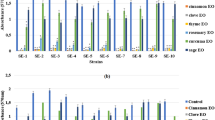Abstract
The essential oil fraction ofOstericum koreanum was analyzed by GC-MS. Inhibiting activities of this oil and its main components were tested by the broth dilution assay and disk diffusion test against one antibiotic-susceptible and two resistant strains ofSalmonella enteritidis andS. typhimurium, respectively. The GC-MS analysis revealed thirty-four compounds; the main components were α-pinene (41.12%), ρ-cresol (17.99%) and 4-methylacetophenone (7.90%). The essential oil ofO. koreanum and its main components were significantly effective against the tested antibiotic-susceptible strains as well as against the resistant strains of the twoSalmonella species, with MICs (minimum inhibitory concentrations) ranging from 2 mg/mL to 16 mg/mL. The anti-Salmonella effects of the oils were dose-dependent on Müller-Hinton agar plates in this experiment. Additionally, checkerboard titer test results demonstrated significant combined effects of streptomycin andO. koreanum oil or cresol, one of the main components of this oil, against the two streptomycin resistant strains ofS. typhimurium, with FICIs ranging from 0.12 to 0.37.
Similar content being viewed by others
References
Alban, L., Olsen, A.-M., Nielsen, B., Sørensen, R., and Jessen, B., Qualitative and quantitative risk assessment for human salmonellosis due to multi-resistantSalmonella typhimurium DT104 from consumption of Danish dry-cured pork sausages.Prev. Vet. Med., 52, 251–265 (2002).
Bidlack, W. R., Omaye, S. T., Meskin, M. S., and Topham, D. K., Phytochemicals as bioactive agents, Technomic Publishing Company, Lancaster, pp. 106–110 (2000).
Chi, H. J. and Kim, H. S., Studies on essential oils of plants ofAngelica Genus in Korea (IV).Kor. J. Pharmacogn., 24, 111–115 (1993).
Choi, H. Y., Guh, Y., and Ham, I., Comparision with essential oils of Angelicae koreanae Radix.Kor. J. Herbology, 19, 169–178 (2004).
Davidson, P. M., and Parish, M. E., Methods for testing the efficacy of food antimicrobials.Food Technol., 43, 148–155 (1989).
Fluit, A. G., Towards more virulent and antibiotic-resistant Salmonella? FEMSImmunol. Med. Mic., 43, 1–11 (2005).
Groll, A. H. and Walsh, T. J., Uncommon opportunistic fungi: new nosocomial threats.Clin. Microbiol. Infec., 2, 8–24 (2001).
Humphrey, T.,Salmonella typhimurium definitive type 104. A multi-resistantSalmonella.Int. J. Food Microbiol., 67, 173–186 (2001).
Jung, Y. S. and Beuchat, L. R., Survival of multidrug-resistantSalmonella typhimurium DT104 in egg powders as affected by water activity and temperature.Int. J. Food Microbiol., 49, 1–8, (1999).
Karlowsky, J. A. and Sahm, D. F., Antibiotic resistance-Is resistance detected by surveillance relevant to predicting resistance in the clinical setting?Curr. Opin. Pharmacol., 2, 487–492 (2002).
Khaschabi, D. and Schopf, K., Occurrence of multi-resistantSalmonella enterica Typhimurium DT 104 in Austria isolated from humans, animals and food.Int. J. Antimicrob. Agents, 25, 272–277 (2005).
Kwon, Y. S., In, K. K., and Kim, C. M., Chemical constituents from the roots ofOstericum koreanum.Kor. J. Pharmacogn., 31, 294–287 (2000).
Lougue, C. M., Sherwood, J. S., Olah, P. A., Elijah, L. M., and Dockter, M. R., The incidence of antimicrobial-resistantSalmonella spp. on freshly processed poultry from US Midwestern processing plants.J. Appl. Microbiol., 94, 16–24 (2003).
Low, J. C., Tennant, B., and Munro, D., Multiple-resistantSalmonella typhimurium DT104 in cats.The Lancet, 348, 1391–1391 (1996).
Mastroeni, P. and Sheppard, M.,Salmonella infections in the mouse model: host resistance factors andin vivo dynamics of bacterial spread and distribution in the tissues.Microbes and Infect., 6, 398–405 (2004).
Matsuura, H., Saxena, G., Farmer, S. W., Hancock, R. E., and Towers, G. H., Antibacterial and antifungal polyine compounds fromGlehnia littoralis ssp.leiocarpa.Planta Med., 62, 256–259 (1996).
McCutcheon, A. R., Stokes, R. W., Thorson, L. M., Ellis, S. M., Hancock, R. E. W., and Towers, G. H. N., Anti-mycobacterial screening of British Columbian medicinal plants.Int. J. Pharm., 35, 77–83 (1997).
Miyazawa, M., Kurose, K., Itoh, A., and Hiraoka, N., Comparison of the essential oils ofGlehnia littoralis from northern and southern Japan.J. Agric. Food Chem., 49, 5433–5436 (2001).
Oluwatuyi M., Kaatz, G. W., and Gibbon, S., Antibacterial and resistance modifying activity ofRosmarinus officinalis.Phytochemistry, 65, 3249–3254 (2004).
Schlegelová, J., Nápravníková, E., Dendis, M., Horváth, R., Benedík, J., Babák, V., Klímová, E., Navrátilová, P., and Sustácková, A., Beef carcass contamination in a slaughterhouse and prevalence of resistance to antimicrobial drugs in isolates of selected microbial species.Meat Science, 66, 557–565 (2004).
Shin, S., Essential oil compounds fromAgastache rugosa as antifungal agents againstTrichophyton species.Arch. Pharm. Res., 27, 295–299 (2004a).
Shin, S.,In vitro inhibitory activities of essential oils fromOenanthe javanica DC againstCandida andStreptococcus species.Natural Product Sciences, 10, 325–329 (2004b).
Shin, S. and Lim, S., Antifungal effects of herbal essential oils alone and in combination with ketocoanzole againstTrichophyton spp.J. Appl. Microbiol., 97, 1289–1296 (2004).
Zhaoa, S., Dattab, A. R., Ayersa, S., Friedmana, S., Walkera, R. D., and Whitea, D. G., Antimicrobial-resistantSalmonella serovars isolated from imported foods.Int. J. Food Microbiol., 84, 87–92, (2003).
Author information
Authors and Affiliations
Corresponding author
Rights and permissions
About this article
Cite this article
Shin, S. In vitro effects of essential oils fromOstericum koreanum against antibiotic-resistantSalmonella spp.. Arch Pharm Res 28, 765–769 (2005). https://doi.org/10.1007/BF02977340
Received:
Issue Date:
DOI: https://doi.org/10.1007/BF02977340



